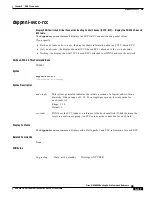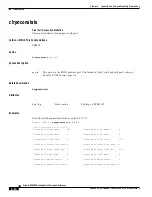
6-4
Cisco MGX 8850 Routing Switch Command Reference
Release 2.0, Part Number 78-10467-04 Rev C0, October 2001
Chapter 6
Logical Node, Port, and Signaling Commands
Identifying Physical and Logical Elements
Apart from the way PNNI and the lower levels of logic identify the same element, the sequence of
commands also needs explanation. When you configure logical ports—for just one example—you must
complete certain tasks on the AXSM CLI before or after related PNNI tasks. For certain commands, this
manual lists prerequisite commands or tasks. For more details on the sequence of tasks, refer to the Cisco
MGX 8850 Routing Switch Software Configuration Guide, Release 2.0, for more details of this sequence.
AXSM Format
On a service module, you identify the follow when you provision the capabilities of the card:
•
Slot
•
Bay
•
Line
•
Logical port
•
Port group
•
Resource partition
Not all of these elements correspond to elements you specify on the PXM45. Subsequent paragraphs
describe only the common elements that are visible on the CLI of the PXM and the service module. The
preceding elements are further defined in the Cisco MGX 8850 Routing Switch Software Configuration
Guide, Release 2.0.
For a UNI or NNI, one logical interface (or logical port) exists per physical line. For virtual network to
network interfaces (VNNIs), you can configure multiple ports on a line. The maximum number of logical
ports on an AXSM is 60 regardless of the AXSM model or the number of lines on the back cards. The
range of logical port numbers is 1–60 for an AXSM regardless of whether the interface type is UNI, NNI,
or VNNI.
PNNI Format
The PNNI controller requires the following format to identify a physical port:
[shelf.]slot[:subslot].port[:subport]
The PNNI physical port identifier (physical port ID) consists of a series of mandatory elements. Note
the period or colon associated with each element inside the square brackets. The elements of the physical
port ID are as follows:
•
The shelf is always 1 for the current product and so is usually omitted.
•
The slot number of the front card.
•
Subslot is the number of the bay where the back card resides. This number is 1 or 2.
•
Port is the physical line.
•
Subport corresponds to the resource partition on the AXSM. For a UNI or NNI, this resource
partition is the same number as the logical port number (ifNum) on the AXSM. For a virtual
network-to-network interface (VNNI), the number does not directly correspond to the
For each physical port number, PNNI also generates a logical port number as an encrypted form of the
physical port number. The logical port number appears as an unformatted numerical string. For example,
a PNNI physical port ID may have the form 1:1.2:2, so the PNNI logical port number would be
16848898. Where needed, the descriptions in the PNNI command chapter define the need for this logical
















































